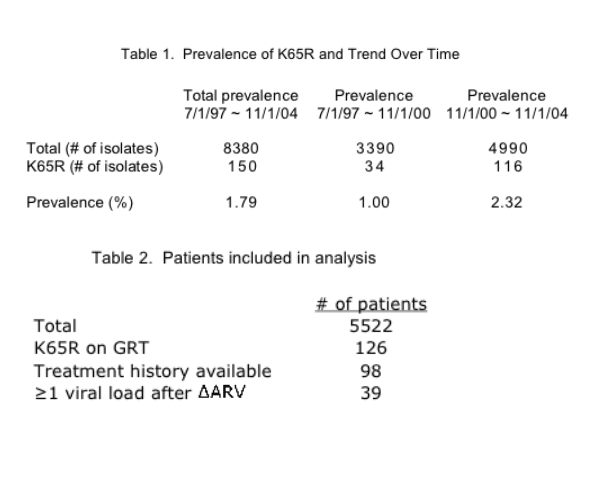 |
 |
 |
| |
Virologic Response to Antiretroviral Therapy in the Setting of the K65R Mutation
|
| |
Reported by Jules Levin
14th Intl HIV Drug Resistance Wksp
June 7-11, 2005
Quebec City, Canada
AB Nevins1, SY Rhee1, WJ Fessel2, M Horberg2, A Scarsella3, SY Lee3, RW Shafer1, AR Zolopa1
1Stanford University, Stanford, CA, 2Kaiser-Permanente Medical Care Program, San Francisco, CA, 3Pacific Oaks Medical Center, Los Angeles, CA
AUTHOR CONCLUSIONS
--In this group of highly treatment-experienced patients with the K65R mutation, response to salvage antiretroviral treatment was associated with a lower baseline plasma viral load, a concomitant M184V mutation, and a higher salvage regimen GSS.
--The K65R mutation appeared to be linked (electrophoretically) with certain TAMs but not with T215Y/F in this cohort.
-- The L74V mutation also only occurred in mixtures suggesting that it was not linked to the K65R, although clonal analysis is required for confirmation of these observations.
--For this group of patients, treatment response was not associated with the number of antiretroviral medications in the salvage regimen, the introduction of a new class of medications, previous antiretroviral use (including TDF), or any specific component of the new regimen, including TDF or AZT, although the number of patients in this cohort may be too small to detect these effects.
-- In the setting of the K65R mutation, patients placed on salvage antiretroviral regimens can show good viral load responses, generally with the use of a PI-based regimen. The range of responses observed here is similar to that of other treatment experienced cohorts with drug resistance mutations other than K65R.
--This study helps to substantiate results from smaller data sets among patients managed in clinical trials that suggest the response to salvage therapy can be robust even in the presence of the K65R mutation.
BACKGROUND
--The K65R reverse transcriptase (RT) mutation confers reduced in vivo susceptibility to each of the NRTIs except zidovudine and possibly stavudine.
--Although the overall prevalence of K65R is low in most databases of clinical samples, its presence on genotype resistance testing (GRT) may impact the selection of antiretroviral medications for subsequent regimens.
--The impact of K65R on virologic response to salvage therapy has not been fully defined.
---We sought to define the impact of K65R on virologic response to antiretroviral therapy in a cohort of treatment experienced patients.
METHODS
--We identified all K65R mutations in HIV-1 clinical specimens from patients followed at three California clinical programs who underwent genotypic resistance testing between 7/1/97 - 11/1/04.
--From 8060 isolates (5522 patients) we found 150 (126 patients) with K65R. Complete treatment histories were available for 98 patients, including 39 with ≥1 HIV-1 viral load determination following the initiation of salvage antiretroviral therapy after the K65R mutation was identified.
--To determine the response to salvage therapy, we examined the antiretroviral drugs and plasma HIV-1 RNA levels that followed the first genotype containing the K65R mutation.
--The Genotype Sensitivity Score (GSS) of individual drugs was inferred using a computerized program that assigns a level of resistance to the antiretroviral drugs targeting RT and protease (HIVdb, http://hivdb.stanford.edu), with a level of 1.0 indicating susceptible (fully active), 0.5 for low/intermediate level resistance (partially active), and 0 for high level resistance (inactive). GSS scores were created by pooling mutations in the baseline genotype and any other preceding genotypes that were available). The lowest GSS (highest level resistance) for each drug was used. The composite GSS for the treatment regimen was created by adding the GSS of each individual ARV in the salvage regimen.
RESULTS
Prevalence of the K65R mutation
--From the 8380 isolates (5522 patients), we identified 150 isolates from 126 unique patients with the K65R mutation.
--The overall prevalence of K65R increased from 1% (7/1/97-11/1/00) to 2.32% (11/1/00 - 11/1/04).


--Mutations M184V, Q151M, and L74V were present in 22 (56%), 7 (18%, three of whom also had M184V), and 3 (8%) of patients, respectively.
--At least one TAM (41, 67, 70, 210, 215, 219) was present in 16 patients (41%); five patients had ≥3 TAMs, three of whom also had M184V and two with Q151M.
--Three patients had T215Y/F on GRT, but only as mixtures of mutant/wild type.
--All L74V mutations were present as part of an electrophoretic mixture with K65R.
--Five patients had no other known resistance mutations.
--Two of the twelve patients who had previously received triple-NRTI therapy had AZT as part of this regimen, and neither as AZT+3TC+ABC.

| |
| |
| |
| |
|
 |
 |
|
|